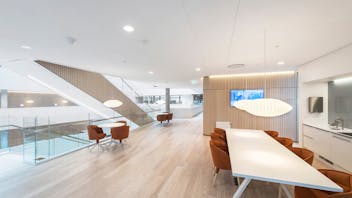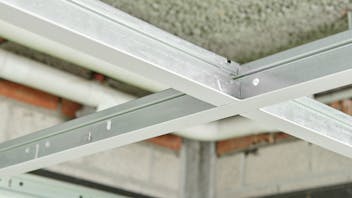In these demanding conditions, ceilings must maintain both an attractive appearance and dependable, sustainable performance.
Transportation facility managers appreciate ceilings that are durable, as well as easily accommodating to lighting, HVAC and security systems. When the equipment and systems require updates, ceilings that allow access to the plenum save time and labor.
When ceiling panels can hold up under these conditions, they also reduce environmental impact, which saves on material costs, conserves resources and lowers associated carbon emissions. According to the U.S. Green Building Council, “Transportation is one of the biggest drivers of CO2 emissions and also has the highest growth in CO2 emissions of any industry sector. …In the U.S., transportation accounted for 27 percent of total greenhouse gas emissions in 2015—second only to electricity production.”1
Contributing to healthier indoor air quality, our stone wool acoustic ceiling products have been certified GREENGUARD® Gold for low emissions. And, our metal ceiling systems also are low-emitting materials with no reportable VOCs.
Our metal and stone wool ceiling panels also resist water and humidity. Because they don’t hold moisture and don’t contain organic material, they provide no sustenance for the growth of mold, mildew or microorganisms that may be unhealthy to passengers and the people they encounter.
Transportation hubs and airport design don’t have to make travelers feel like they’re rushing through Grand Central Terminal.
With planes taking off and landing, trains arriving and departing, cars picking up and dropping off, and lots of busy travelers in large, open spaces, transit facilities can be very loud and very stressful. The most stressful part of travel is at the start of the passenger path because we feel a lack of control in the rush to make departure times and find our way among the noisy crowd.
The right ceiling can have a profound effect on both the acoustic experience and on the overall travel experience. Acoustic ceiling panels and baffles with high sound absorption can control the noise level of these busy spaces. In a quieter environment, travelers feel more relaxed, can hear pertinent announcements more clearly, can better understand spoken instructions and are better able to communicate important information.2
In interior spaces, stone wool ceiling acoustic tiles installed in a suspended grid create the typical drop ceiling and provide sound absorption. In airport concourses, bus station main halls, train station terminals and other large open spaces, acoustic ceiling baffles and metal ceilings are frequently the preferred product choice. Metal ceiling panels and planks can be perforated and enhanced with an acoustic backing material to improve sound management. Acoustic ceiling baffles or islands also provide noise control when suspended ceiling systems are not practical or as an aesthetic alternative.












